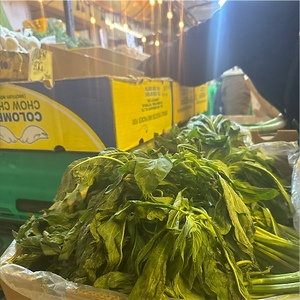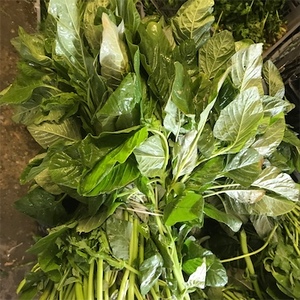


Pigweed Leaves
Estimated Inventory, lb : 0
Description/Taste
Pigweed, depending on the species, varies in size from small, low to the ground, to larger up to 1-3 meters in height. The oval to diamond-shaped leaves develop in alternating patterns, ranging in color from green to maroon, and have a rounded tip with prominent veins branching across the surface. The leaves are also broad, flat, and pliable, sometimes appearing smooth while other species are covered in fine hairs, and connect into slender, green stems that become thicker at the base. On top of the plant, green flowers form in compact clusters, eventually giving way to small black or dark red seeds. The entire plant is edible, including the leaves, seeds, flowers, and stems. Pigweed leaves have a green and slightly astringent-sweet flavor with a semi-coarse texture.
Seasons/Availability
Pigweed leaves are available year-round, with a peak season in the late spring through fall.
Current Facts
Pigweed, also known as Amaranth, is a general descriptor used for a broad category of plants that are members of the genus Amaranthus and also belong to the Amaranthaceae family. There are hundreds of species of Pigweed across the world, all varying slightly in size, shape, and color, and range from growing wild to being domesticated for culinary and ornamental use. Pigweed is a prolific plant that is exceptionally resilient, often earning it the title of a weed, and a single plant can develop over one-hundred thousand seeds making it a difficult species to contain. Pigweed also favors disturbed soils and is considered a common weed to find in commercial vegetable fields, competing for nutrients and disrupting other plant growth. Despite its aggressive growth habits, Pigweed is valued in countries such as Africa, Greece, Mexico, China, and India for its nutritional seeds and leaves, and is often consumed as a spinach-like side dish. The most common varieties of Pigweed include Redroot Pigweed, Smooth Pigweed, Prostrate Pigweed, Palmer Amaranth, and Tumble Pigweed.
Nutritional Value
Pigweed leaves are a good source of vitamins A and C, iron, calcium, fiber, folate, and niacin.
Applications
Pigweed leaves can be utilized raw in green salads, but they are most popularly steamed, sautéed, baked, boiled, or fried. Prepared similarly to spinach but developing a firmer texture once cooked, Pigweed leaves can be stir-fried with other vegetables and served over rice, torn and tossed into soups and curries, sautéed into omelets, or simmered in broth with scallions and served cold with yogurt. Pigweed leaves are also popularly baked into quiches, used as a topping on pizza, shredded into tacos, stuffed into savory pastries, mixed into pasta, or torn and mixed into pesto. In addition to the leaves, the seeds are edible and can be ground into a flour for use in bread or as a thickener. Pigweed pairs well with tofu, meats such as poultry, pork, and beef, basil, turmeric, mustard, mushrooms, avocadoes, tomatoes, polenta, cranberries, almonds, and raisins. The fresh leaves should be used immediately for best flavor and quality, but they will also keep 1-2 days when cooked and stored in the refrigerator.
Ethnic/Cultural Info
Pigweed has been utilized in cooking for thousands of years but has recently increased in notoriety among culinary foragers as it is readily found growing in the wild, is extremely versatile in dishes, and provides an excellent source of nutrients. In the Caribbean, Pigweed is used in the traditional dish known as callaloo, which was created in West Africa and has been adopted into Caribbean cuisine. In callaloo, Pigweed is cooked with peppers, garlic, onions, and tomatoes and is served with yams, rice, or bread. Pigweed is also used in morogo, a South African stew that simmers the greens with scallions, cornmeal, and salt, and is served as a stand-alone broth or topped over bread and crostini. In Asia, Pigweed is commonly mixed into stir-fries or lightly sautéed and served with cooked meats. The large leaves are also valued as an ornamental and are widely grown in backyard containers.
Geography/History
Pigweed is native to the Americas and has been spread across the world, transported along trade routes and through migrating peoples. The leafy plants have been found growing wild and have also been cultivated on a small scale since ancient times, and today Pigweed can be found at local markets in Europe, Asia, Africa, Australia, and North, Central, and South America.
Recipe Ideas
Recipes that include Pigweed Leaves. One
| Gardenista |
|
Pigweed Taco |









